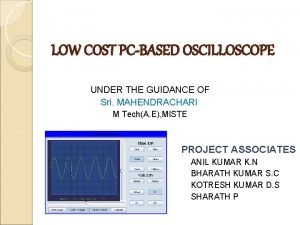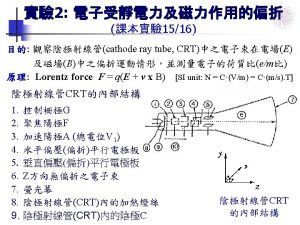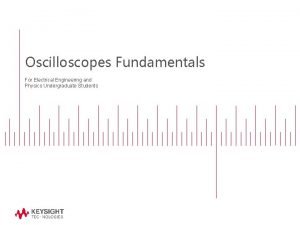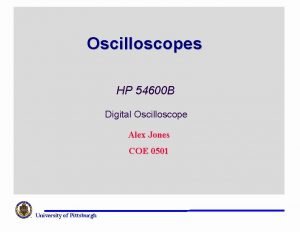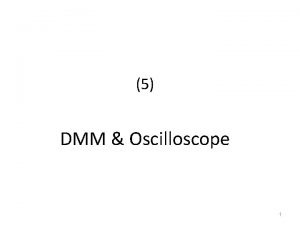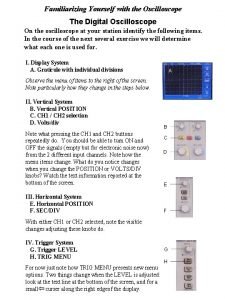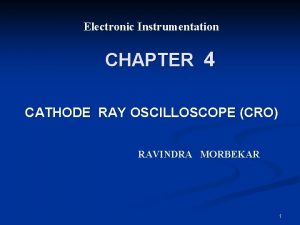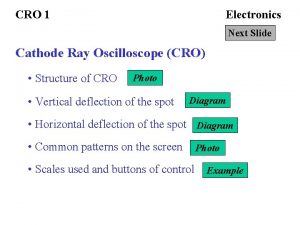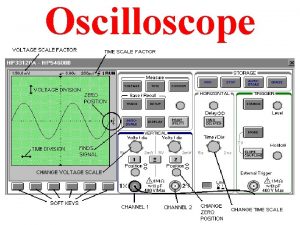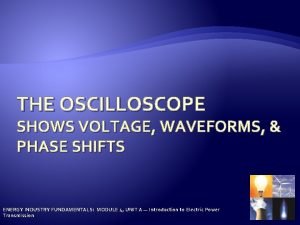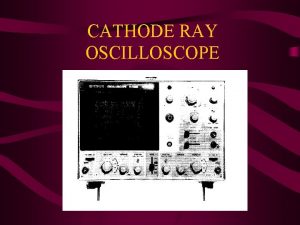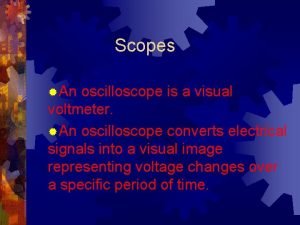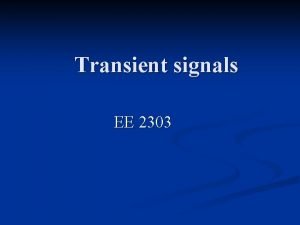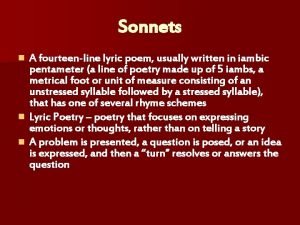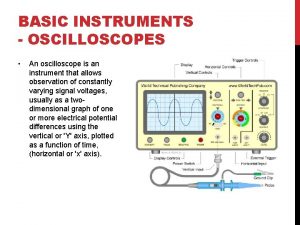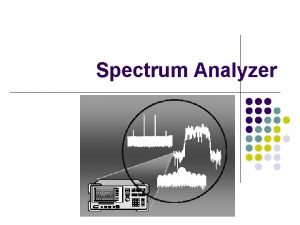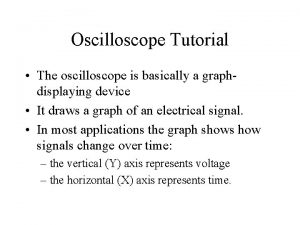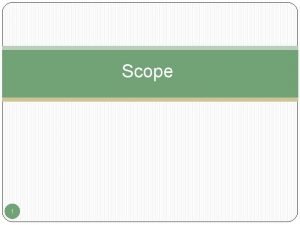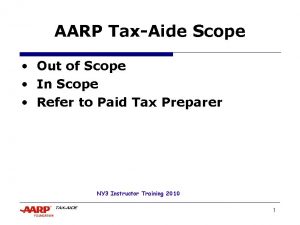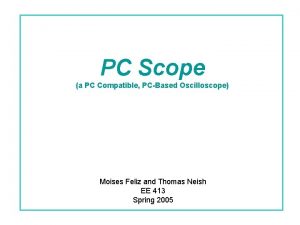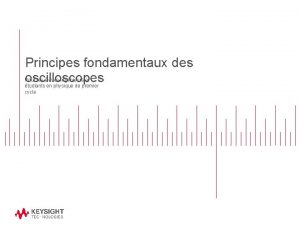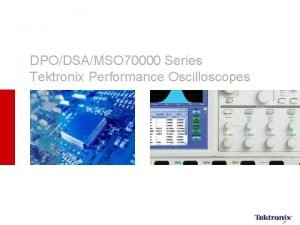OSCILLOSCOPES An oscilloscope usually called a scope is





































- Slides: 37

OSCILLOSCOPES An oscilloscope (usually called a scope) is a visual voltmeter with a timer (clock) that shows when a voltage changes. An analog scope uses a cathode ray tube (CRT) similar to a television screen to display voltage patterns.

OSCILLOSCOPE DISPLAY GRID Setting the Time Base Most scopes use 10 graticules from left to right on the display. Setting the time base means setting how much time will be displayed in each block. A block is commonly referred to as a division. The vertical scale has eight divisions. If each division is set to equal 1 volt, the display will show 0 to 8 volts. This is okay in a 0 to 5 volt variable sensor such as a throttle position (TP) sensor. The volts per division (V/div) should be set so that the entire anticipated waveform can be viewed

OSCILLOSCOPE DISPLAY GRID Frequency is the number of cycles per second measured in hertz. Engine RPM signal is an example of a signal that can occur at various frequencies. At low engine speed, the ignition pulses occur fewer times per second (lower frequency) than when the engine is operated at higher engine speeds (RPM).

ELEKTRONIKOS ĮTAISAI 4 2009 Cathode-ray tubes The cathode ray tube (CRT), invented by German physicist Karl Ferdinand Braun in 1897, is an evacuated glass envelope containing an electron gun (a source of electrons) and a fluorescent screen, usually with internal or external means to accelerate and deflect the electrons. When electrons strike the fluorescent screen, light is emitted. The electron beam is deflected and modulated in a way which causes it to display an image on the screen. The image may represent electrical waveforms (oscilloscope), pictures (television, computer monitor), echoes of aircraft detected by radar, etc. A cathode ray tube (CRT) contains four basic parts: • electron gun, • focusing and accelerating systems, • deflecting systems, and • evacuated glass envelope with a phosphorescent screen that glows visibly when struck by the electron beam. VGTU EF ESK stanislovas. staras@el. vgtu. lt

Cathode-ray tubes. Cathodoluminescence The deflected and accelerated electron beam strikes a phosphorescent material on the inside face of the tube. The phosphor glows and the visible glow can be seen at the front of the tube. So cathodoluminescence is used in cathode ray tubes. Cathodoluminescent efficiency increases with increasing beam voltage. As a result of the screen bombardment free electrons are knocked out. To collect these electrons the inside surface of the glass balloon is coated by conducting aquadag layer. Usually this layer is connected to the accelerating anode. The screen of the CRT may be coated with aluminium on the inside and this coating is held at anode potential. Such an aluminized screen prevents the accumulation of charge on the phosphor and improves its performance increasing the visible output and reducing the effects of ion bombardment.

Functional Units a) Electron Gun b) Evacuated Tube c) Deflecting System d) Time Base e) Trigger Circuit

Electron Gun

a) Heating Filament b) Cathode c) Grid d) Electron lens Return Link to figure

Cathode-ray tubes. Electrostatic focusing Two or more electrodes at different potentials are used to focus the electron beam. The electrostatic field set up between the electrodes causes the beam to converge. The focusing effect is controlled by varying the potential of the focusing electrode. The system of converging and diverging lenses Due to the focusing action electrons of the gun bombard the screen of the cathode ray tube at the same point.

Cathode-ray tubes. Electrostatic focusing

ELEKTRONIKOS ĮTAISAI 11 2009 Cathode-ray tubes. Electromagnetic focusing Focus coil The focusing magnetic field is inhomogeneous and axial symmetrical. Cathode ray tube employing electromagnetic focus and deflection VGTU EF ESK stanislovas. staras@el. vgtu. lt

ELEKTRONIKOS ĮTAISAI 12 2009 Cathode-ray tubes. Electrostatic deflection Screen Electron beam Sensitivity VGTU EF ESK stanislovas. staras@el. vgtu. lt

ELEKTRONIKOS ĮTAISAI 13 2009 Cathode-ray tubes. Electromagnetic deflection Vertical deflection coil Glass balloon NI is the number of ampere-turns The sensitivity of a CRT with electrostatic deflecting system is in inverse ratio to U 0. In the case of electromagnetic deflection it is in inverse ratio to. Using electromagnetic deflection we can obtain relatively great sensitivity and great deflection angle at high accelerating voltage. For this reason electromagnetic deflection is used in television picture tubes, requiring highvelocity electron beams necessary for bright display. VGTU EF ESK stanislovas. staras@el. vgtu. lt

ELEKTRONIKOS ĮTAISAI 14 2009 Cathode-ray tubes. Electromagnetic deflection VGTU EF ESK stanislovas. staras@el. vgtu. lt

ELEKTRONIKOS ĮTAISAI 15 2009 Cathode-ray tubes. Electromagnetic deflection VGTU EF ESK stanislovas. staras@el. vgtu. lt

ELEKTRONIKOS ĮTAISAI 16 2009 Cathode-ray tubes. Electromagnetic deflection VGTU EF ESK stanislovas. staras@el. vgtu. lt

Evacuated Tube Vacuum space Screen Graphite inner wall Shielded from electric and magnetic fields Return Link to figure

Deflecting System X-plates Y-plates X and Y Deflection Amplifiers X-shift Control Y-shift Control Sensitivity Control Return Link to figure

Time Base Sawtooth potential difference Time period control Return Link to figure

Trigger Circuit Maintain a stable trace Trig level control Trigger time base automatic triggering

USES OF CRO a) Voltmeter b) Display of waveforms c) Measurement of short time intervals d) Measurement of frequency e) Display of phase relationship f) Comparison of frequencies

Voltmeter Calibration D. C. voltmeter Advantages over moving-coil voltmeters Return

Display of Waveforms

Measurement of Short Time Intervals Calibrate for the time base Measure a very small time interval, e. g. measurement of sound speed in a metal rod

Measurement of Frequency Signal applied to Y-plates ‘Lock’ the trace Choose a suitable time base Determine the period, T Calculate the frequency

Display of Phase Relationships

Comparison of Frequencies Lissajous’ figures Frequency ratio

OSCILLOSCOPE DISPLAY GRID Duty Cycle Duty cycle refers to the percentage of on-time of the signal during one complete cycle. FIGURE 10 -5 (a) A scope representation of a complete cycle showing both on-time and offtime. (b) A meter display indicating the on-time duty cycle in percent (%). Note the trigger and negative () symbol. This indicates that the meter started to record the percentage of on time when the voltage dropped (start of on-time). (Courtesy of Fluke Corporation)

OSCILLOSCOPE DISPLAY GRID Pulse Width The pulse width is a measure of the actual on -time measured in milliseconds. Fuel injectors are usually controlled by varying the pulse width. FIGURE 10 -6 Most automotive computer systems control the device by opening and closing the ground to the component. (Courtesy of Fluke Corporation)

Setting The Time Base • • • Most scopes use ten divisions from left to right on the display. The time base indicates how much time will be displayed in each division. For example, if the scope is set to read 200 m. V (0. 200 V) per division, then the total displayed would be 2 sec (0. 200 X 10 divisions = 2 sec). ms/division Total time 1 10 ms (0. 010 sec) 10 100 ms (0. 100 sec) 50 500 ms (0. 500 sec) 100 1 sec (1. 000 sec) 500 5 sec (5. 0 sec) 1000 10 sec (10. 0 sec)

OSCILLOSCOPE DISPLAY GRID External Trigger ◦ An external trigger is when the trace starts when a signal is received from another (external) source. Trigger Level ◦ The trigger level must be set to start the display. Trigger Slope ◦ The trigger slope is the voltage direction that a waveform must have in order to start the display.

OSCILLOSCOPE DISPLAY GRID FIGURE 10 -7 (a) A symbol for a positive trigger—a trigger occurs at a rising (positive) edge of the signal (waveform). (b) A symbol for a negative trigger— trigger occurs at a falling (negative) edge of the signal (waveform).

OSCILLOSCOPE DISPLAY GRID Measuring Battery Voltage with a Scope One of the easiest things to measure and observe on a scope is battery voltage. A lower voltage can be observed on the scope display as the engine is started and a higher voltage should be displayed after the engine starts.

OSCILLOSCOPE DISPLAY GRID Measuring Battery Voltage with a Scope FIGURE 10 -8 Battery voltage is represented by a flat horizontal line. In this example, the engine was started and the battery voltage dropped to about 10 V as shown on the left side of the scope display. When the engine started, the generator (alternator) started to charge the battery and the voltage is shown as climbing.

GRAPHING MULTIMETER A graphing multimeter, abbreviated GMM, is a cross between a digital meter and a digital storage oscilloscope. A graphing multimeter displays the voltage levels on a display and a digital readout. FIGURE 10 -9 A typical graphing multimeter.

CAN SCOPES MEASURE CURRENT? FIGURE 10 -10 The fused jumper wire is connected to terminals 30 and 87 of the fuel pump relay socket. The current probe is shown clamped around the wire and the electronics in the probe convert the current reading into a millivolt signal that is used by the DSO to display the changing current waveform.

37 2009 Cathode-ray tubes. Electron gun An electron gun consists of a serie ELEKTRONIKOS ĮTAISAI of electrodes producing a narro beam of high-velocity electrons. Electrons are released from th indirectly heated cathode. The intensity of the beam controlled by variation of th negative potential of the cylindric control grid surrounding the cathode This electrode is called th modulator. The control grid has a hole in th front to allow passage of the electro beam. The electrons are accelerated an focused. VGTU EF ESK stanislovas. staras@el. vgtu. lt
 Low cost oscilloscopes
Low cost oscilloscopes An oscilloscope display grid or scale is called a
An oscilloscope display grid or scale is called a Cathode ray oscilloscope animation
Cathode ray oscilloscope animation Oscilloscope theory
Oscilloscope theory 54622d
54622d Hp 54600
Hp 54600 Difference between dmm and oscilloscope
Difference between dmm and oscilloscope Oscilloscope
Oscilloscope Block diagram of oscilloscope
Block diagram of oscilloscope Cro in electronics
Cro in electronics Oscilloscope is basically a
Oscilloscope is basically a Phase shift oscilloscope
Phase shift oscilloscope L crt
L crt Block diagram of cathode ray oscilloscope
Block diagram of cathode ray oscilloscope Cathode ray oscilloscope function
Cathode ray oscilloscope function What is in the image
What is in the image Oscilloscope fundamentals
Oscilloscope fundamentals Voltmeter vs oscilloscope
Voltmeter vs oscilloscope Oscilloscope coaxial cable
Oscilloscope coaxial cable Signal generator proteus
Signal generator proteus High pitch oscilloscope
High pitch oscilloscope Transient signal oscilloscope
Transient signal oscilloscope In an oscilloscope tube what is the purpose of the heater
In an oscilloscope tube what is the purpose of the heater Process scope definition
Process scope definition Product scope vs project scope
Product scope vs project scope Yoga and reza ... do their homework last night.
Yoga and reza ... do their homework last night. Sometimes every day usually
Sometimes every day usually What two locations are marine ecosystems usually located
What two locations are marine ecosystems usually located Who usually likes our folk songs
Who usually likes our folk songs The sign for an uncontrolled railroad crossing is a
The sign for an uncontrolled railroad crossing is a Eaten plain i am usually white
Eaten plain i am usually white Shapes that have smooth edges and are measurable
Shapes that have smooth edges and are measurable A data model is usually graphical.
A data model is usually graphical. Quarter turn belt drive
Quarter turn belt drive Usually
Usually The high rate of poaching of rhinoceros is due mostly to
The high rate of poaching of rhinoceros is due mostly to Cause and effect examples
Cause and effect examples A 14 line lyric poem
A 14 line lyric poem
